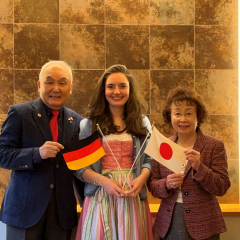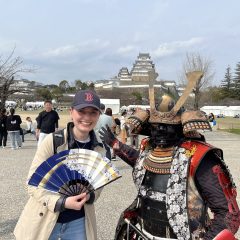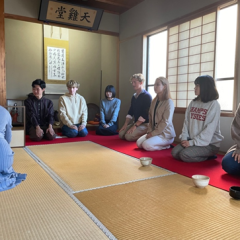☆☆☆second report of Felicitas Künlen,23rd scholarship holder of the GRÜNWALD foundation☆☆☆
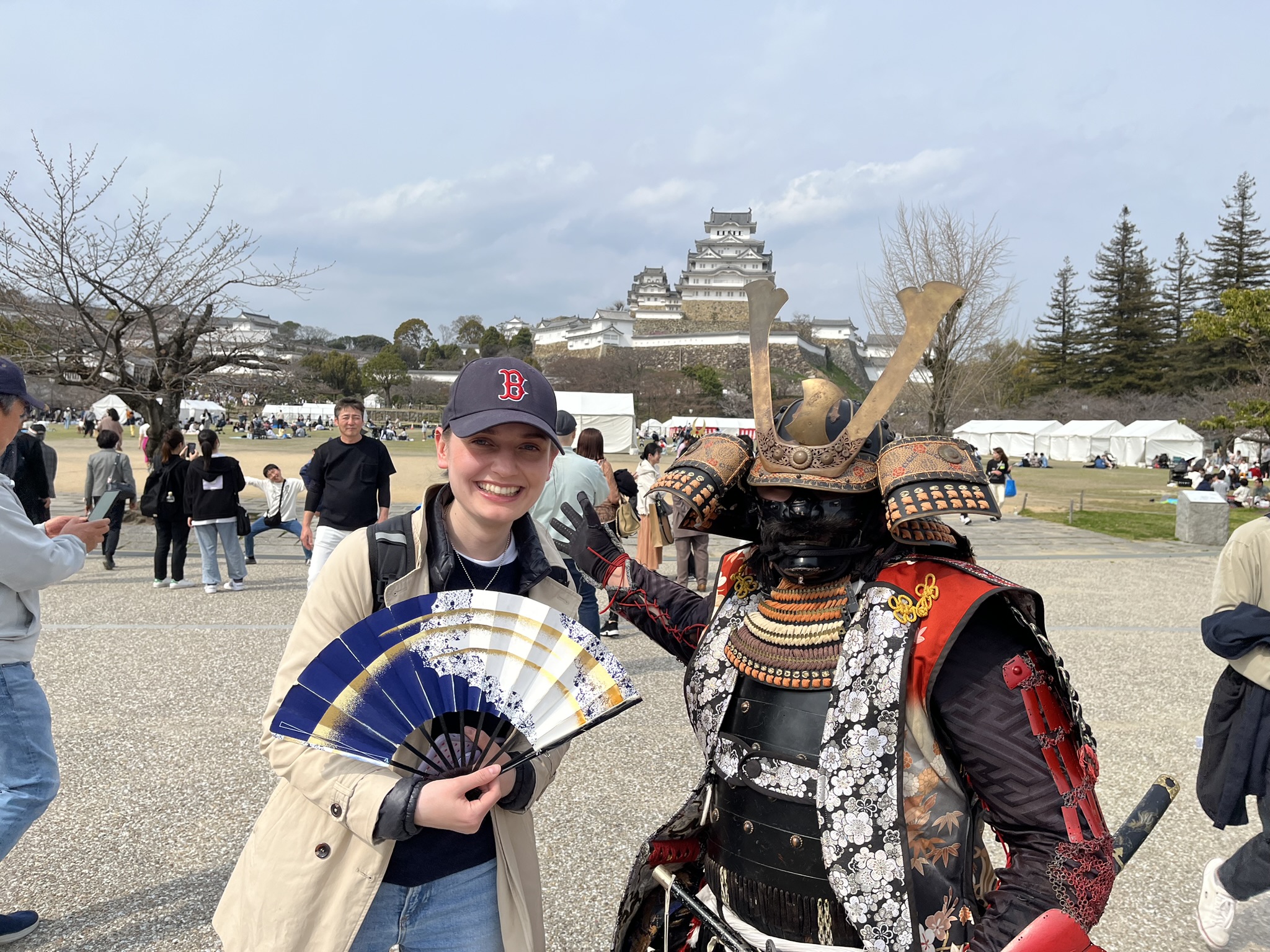
Kyoto, Monday afternoon, 18 March, 1 pm. Dr Prof Aoji is waiting for me with three
Japanese students at Karasuma-Oike underground station. They start shrieking happily and clapping their hands when they see me. Together we take a trip to the botanical garden, visit Kyoto University and the Shimogamo Shrine. Afterwards, Prof Aoji invites us to ”mitarashi dango”, a kind of salty motchi. A wonderful day, accompanied by stimulating conversations about Japanese life and study.
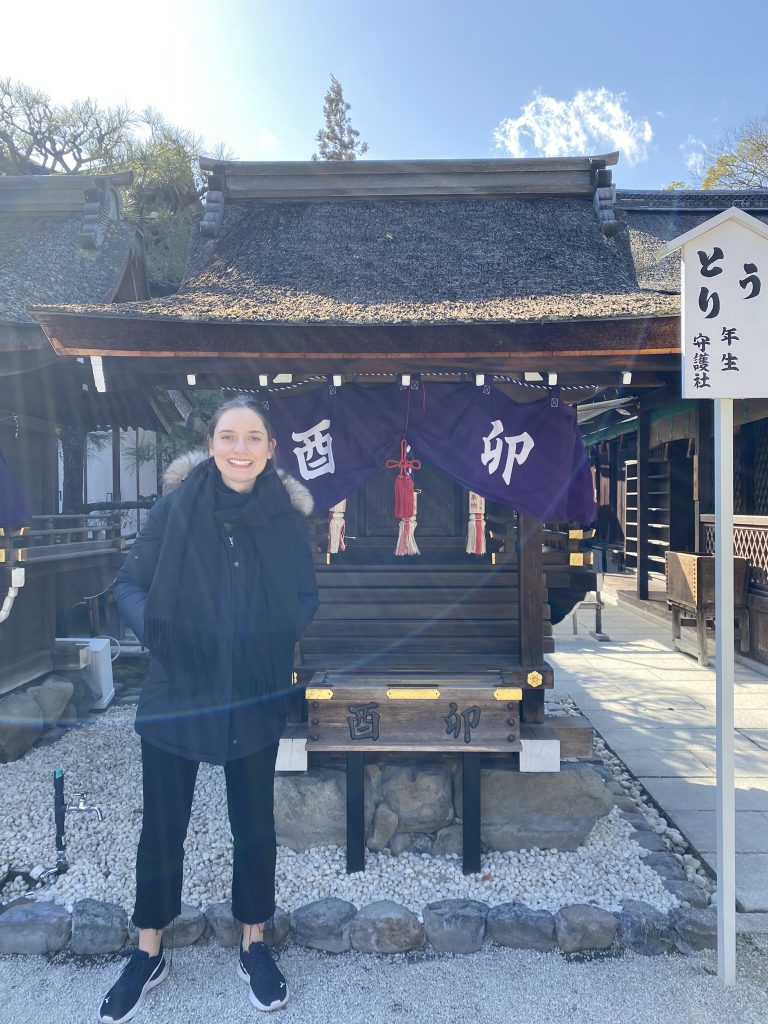

In front of the hare altar at Shimogamo Shrine. Rabbit is my star sign in the Chinese
horoscope (year of birth 1999).
The following evening I went to the German language table, where you have to throw 100 YEN into a piggy bank for every Japanese word you speak – so I get off cheaply. In addition to the usual topics that Germans ”love” and must be discussed abroad (the war in Ukraine and the C virus), the next topic was health, or more precisely: what do you do to stay healthy? After I gave the participants a short lecture on the benefits of ”oil pulling in the morning”and
”drinking apple cider vinegar (drink a tablespoon in a glass of warm water in the morning, it’s a natural antibiotic, has an antibacterial and anti-inflammatory effect and strengthens the immune system)”, my Japanese fellow participant said briefly and succinctly: ”I drink Franconian wine for my health”. Of course that’s how it works!
I have the next two days off – so I use my time to walk around Osaka and see everything Chat-GPT suggests like a good tourist. But what Chat-GPT hasn’t considered is the weather! The cherry blossom is not yet in bloom and spring is showing its ugly side. I make my way to the ”Yasaka Shrine” in a five-degree headwind and rain. The big dragon’s mouth doesn’t seem to mind the weather, but it’s getting too much for me. I make my way back in an orderly fashion and decide to find an indoor activity for the next day.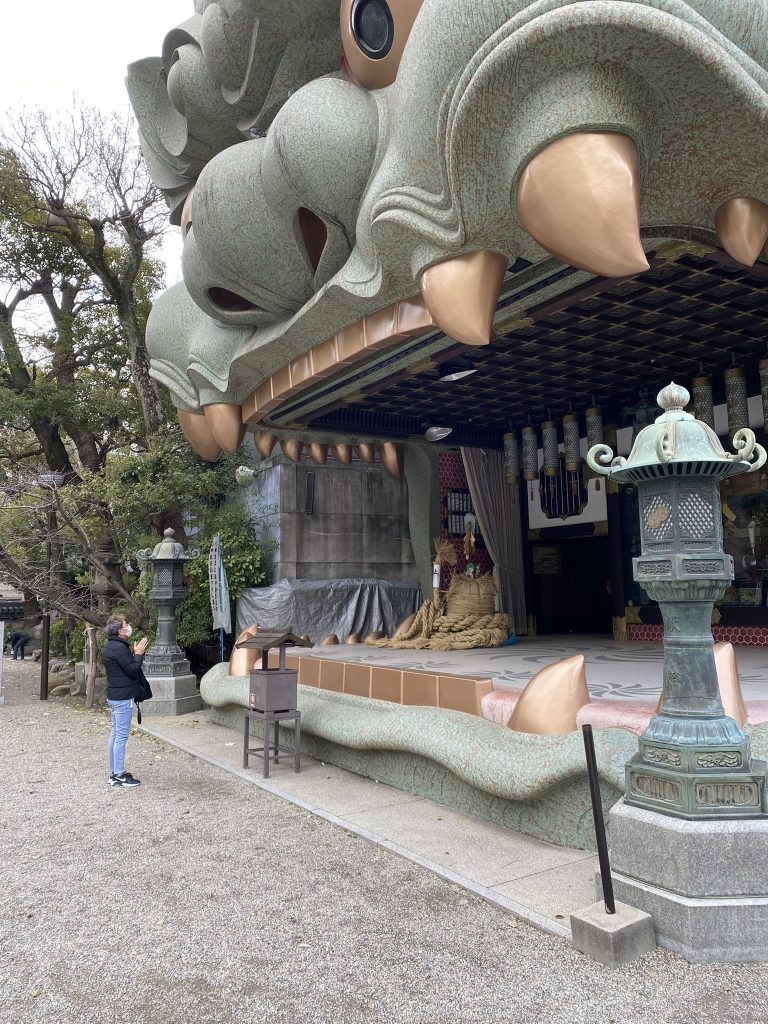
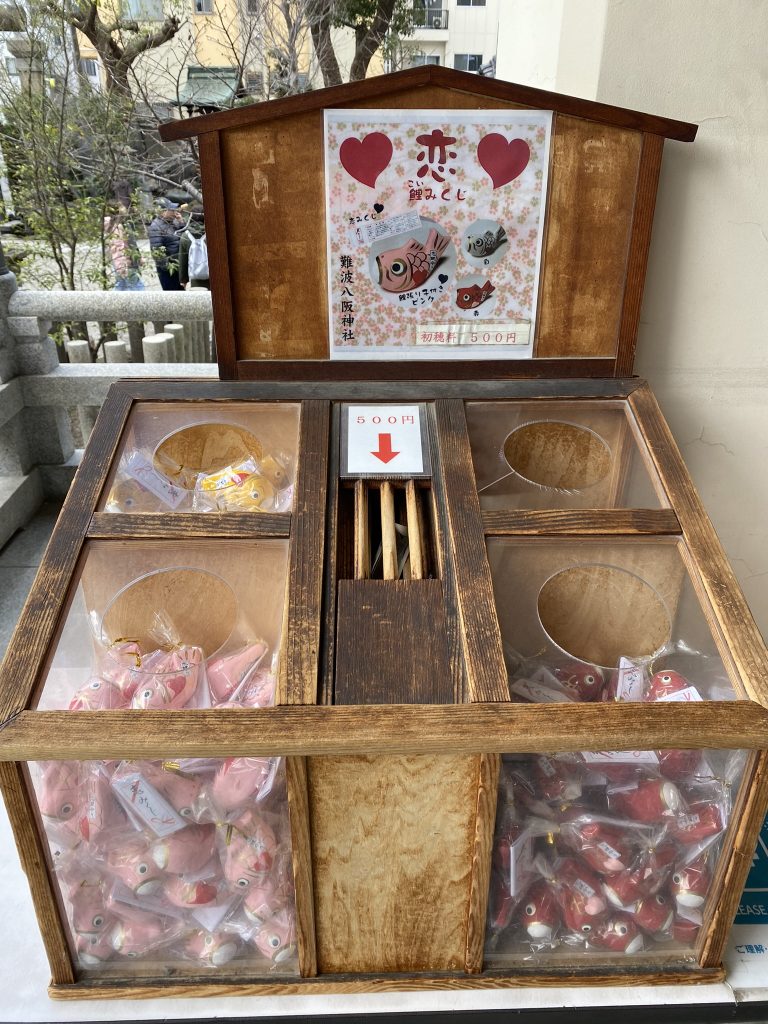
A believer stands praying in front of the Yasaka Shrine, I buy a lucky fish as a souvenir
No sooner said than done – on 21 March I visit the Osaka Historical Museum. Unfortunately, many of the descriptions are only in Japanese and I understand – well, just about everything. But what I realise is that Osaka has always been an important city, then as now. And you have a great view of Osaka Castle from above. However, I could have saved myself the subsequent visit to the castle, at least from the inside. Together with a horde of other tourists, you are chased up floor after floor. The crowds are actually too much for me and I’m about to turn back when I tell myself that I don’t want to have paid the entrance fee for nothing. The inner quarter-Swabian in me has probably won the day!
In front of Osaka Castle
Friday, 22 March A spiky little ball called wasabi lies on my knees. A little nose moves in the air and seems to smell mealworms. I take a sip of green tea from my flask and listen to the classical music in the background. In short – I’ve ended up in a hedgehog café. Yesterday Japanese house pig – today African white-bellied hedgehog: themed cafés in Japan can be very diverse! In the hip and noisy neighbourhood of Namba, the small room with seven hedgehogs feels like an oasis of calm. For the equivalent of 13 euros, I can isolate myself from the outside world for an hour. Garden gloves and four mealworms are included. For an extra two euros, I can take Polaroids with the little wasabi.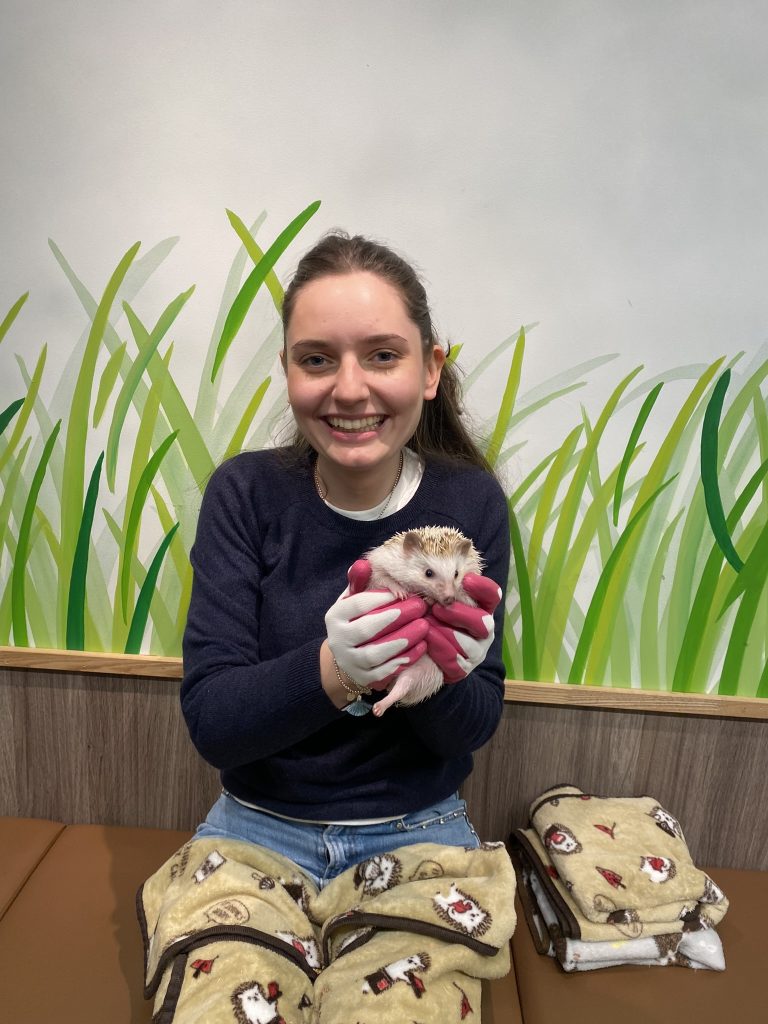

Wasabi and me – what else could the little Japanese spiky ball be called?
The following day I was privately invited to Dr Prof Aoji’s house. As well as teaching at
Kyoto Prefectural University, he is a priest and runs a temple. A tea ceremony, classical music and sushi awaited me there. His student, who is also completing a three-year training programme to become a tea master, led the tea ceremony. Each hand movement is devoutly performed with elegance and ease, as in a ballet choreography, before the green ”gold”, aka matcha powder, is whisked into a froth with hot water in the pretty bowls. We participants sit reverently on our knees and watch the ”tea dance”. Only I, as a ”long-haire” European, was offered a stool. (M)A great stroke of luck, as it turned out later, because even the Japanese, who were probably more used to the kneeling position than I was, fell asleep after half an hour. Afterwards, his female students played pieces by German composers on the piano and flute and we talked about music while eating sushi: I was at least able to score points with my
knowledge of German hip-hop.

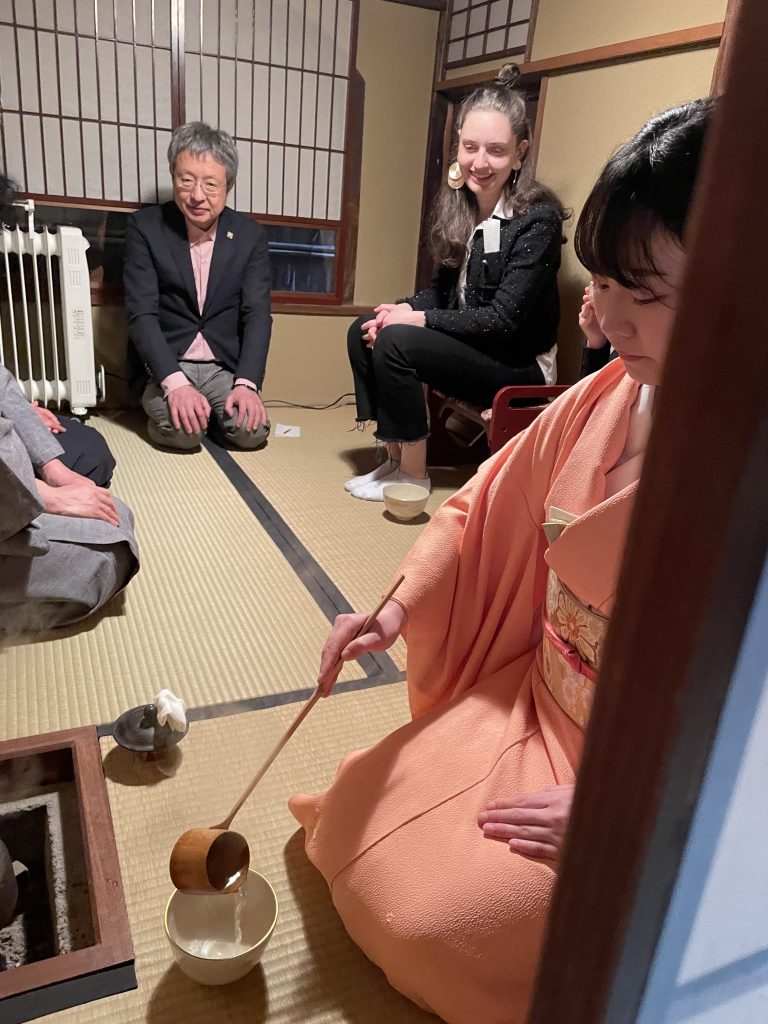
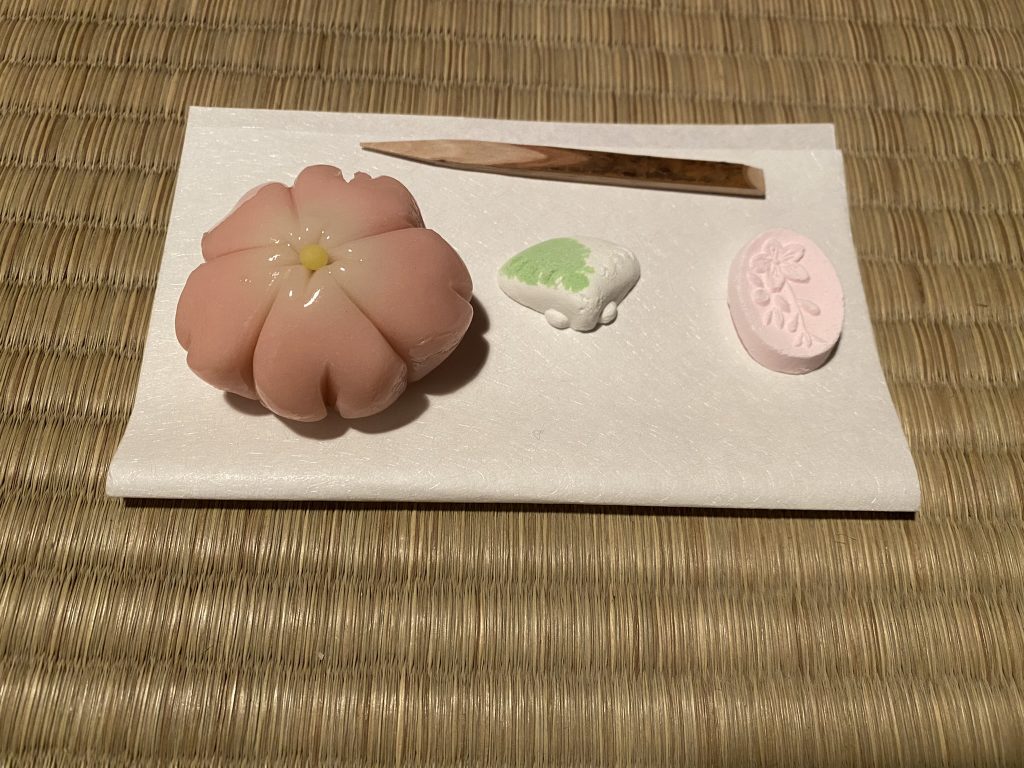
Afternoon with Dr Prof Aoji with tea ceremony and traditional pastries
I decide to take it easy on Sunday – after all, I have a busy week ahead of me. So I (once again) take a relaxed stroll through the ‘America-Mura’ neighbourhood and look at second-hand clothes. After my discovery last week (a jacket with a German eagle on it), my find this week is a traditional Bavarian jacket with staghorn buttons hanging in the front row of a clothes rail. Maybe I’ll find a pair of lederhosen next week…
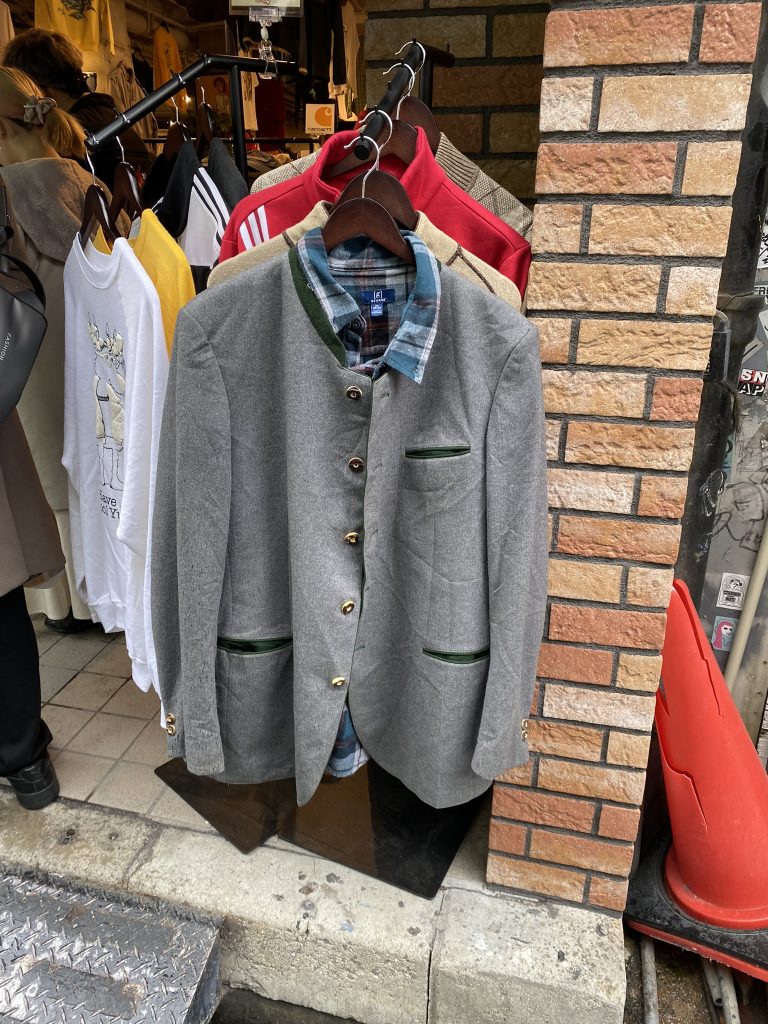
I get up early on 25 March, as I have to catch my Shinkansen to Tokyo at 7.30am. My
intuitive flash of inspiration to turn back and take my umbrella with me turns out to be one of the smartest ideas I’ve ever had. Because it’s raining cats and dogs in Tokyo. German as I am, I nevertheless decide to go through with the solo travel programme that I had meticulously planned in Osaka. Day 1: Visit to the famous ‘Meiji Shrine’. Alongside many other tourists, there are beautiful old trees and the forest air does me good. Only when every last fibre of my size 38 dark blue trainers has been soaked by the tokyo rainwater do I decide to change my itinerary after all.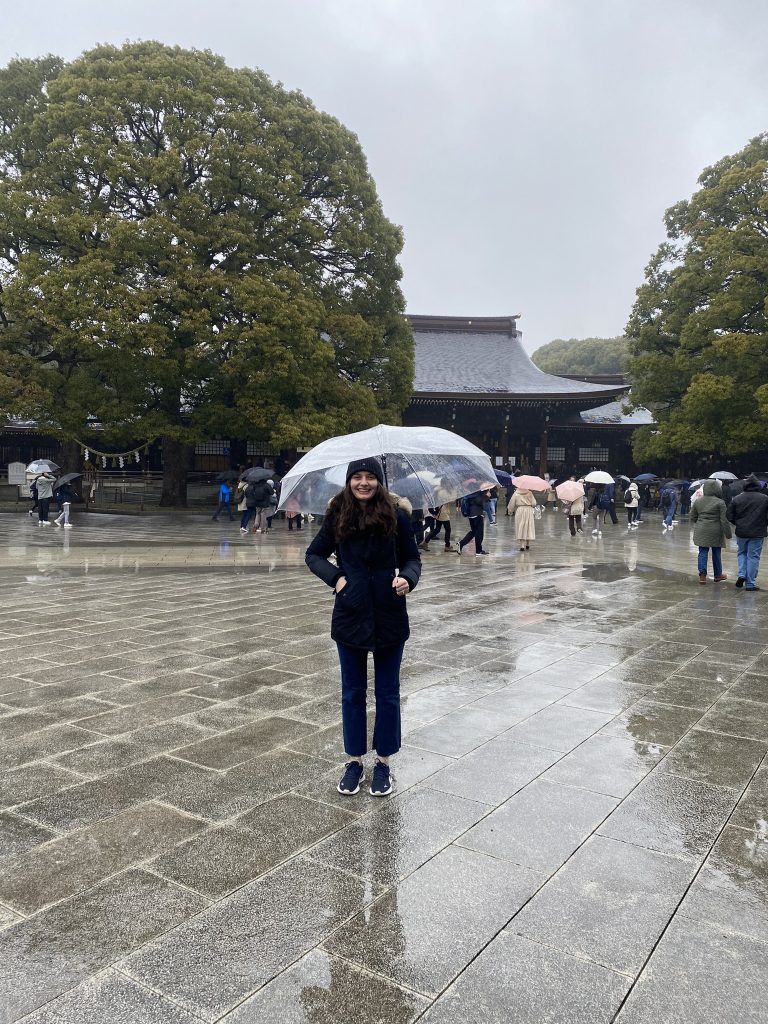
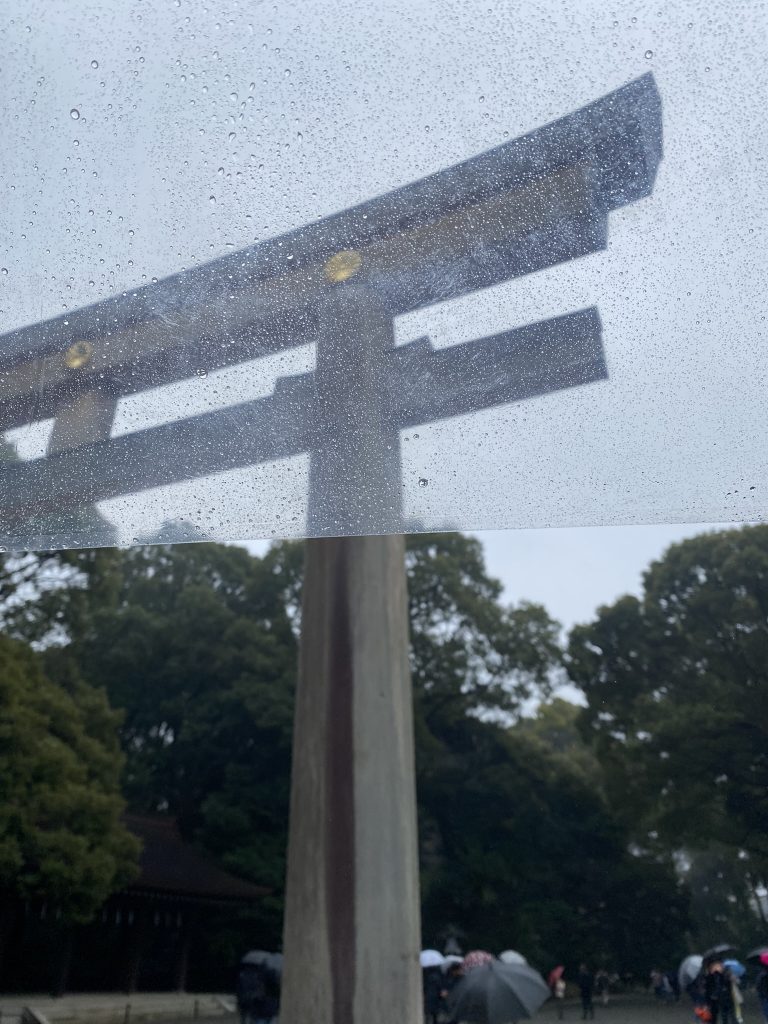
Meiji Shrine in the rain. I look at the shrine through my typical Japanese transparent
umbrella, which is covered in raindrops.
Instead of the Imperial Palace, I go to the shopping mall ”Shibuya”. This seven-storey
shopping paradise is particularly popular with young Japanese women. The mostly heavily made-up and contact lens-wearing girls with short skirts stock up here for the latest season. For me as a trainers tourist with wet shoes and a dripping umbrella, without contact lenses, there are new trousers and white socks with hearts on them. When the rain subsides, I walk through the ”Shibuya” district with its colourful lights and countless love hotels. Up the so-called ”Spanish Slope” – and I’m standing in front of the ”Chiyoda Inari Shrine”. Romantically nestled between the love hotel ”Moti” with its red façade and a drinks vending machine, the temple stands quietly waiting for visitors. Incidentally, you can see directly into the temple from the balcony of the hotel – very practical, in my opinion: you can pray right down ”afterwards”. After the obligatory Shibuya crossing, I buy some sushi and take the Shinkansen back home. Tokyo may be a cool city, but I’m still pretty exhausted after just one day there.
The ”city” makes my heart beat faster than Osaka.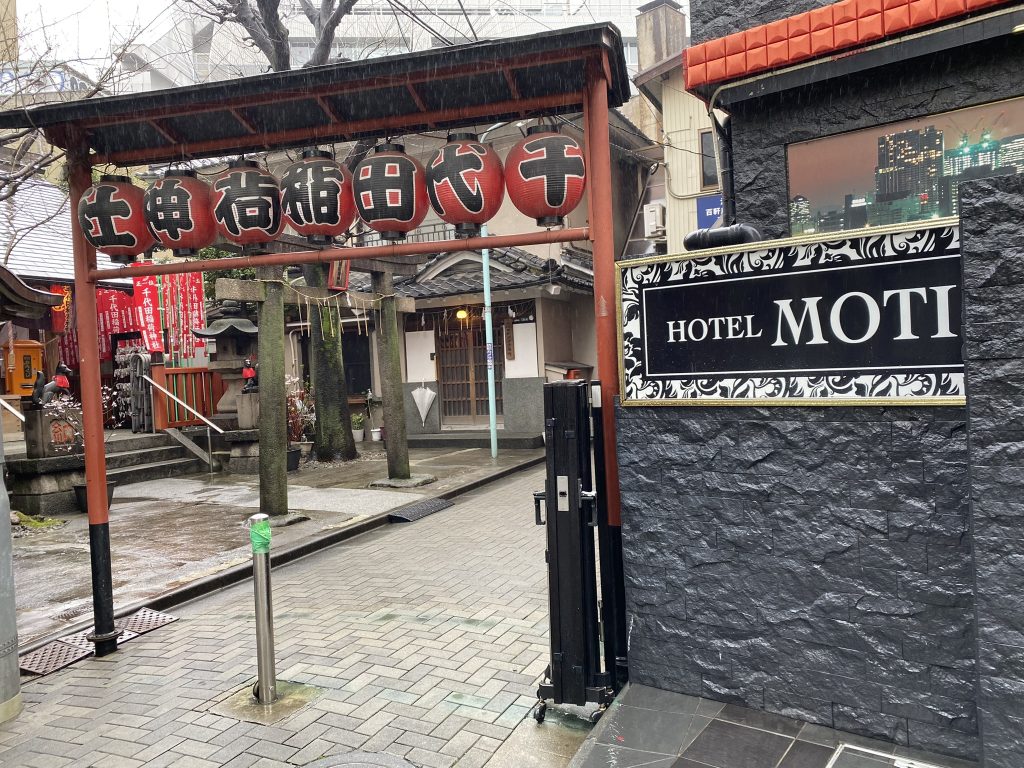
Temple between love hotel and vending machine
The following two days in Wakayama Koyasan provide me with the counter-programme to the hectic city. I am allowed to stay privately with the lovely Yoshimatsu family. These are two very special days, as it turns out in retrospect. The couple, both in their mid-seventies, pick me up at Wakayama station on Tuesday morning. After lunch together, we drive to Wakayama Castle in their car.
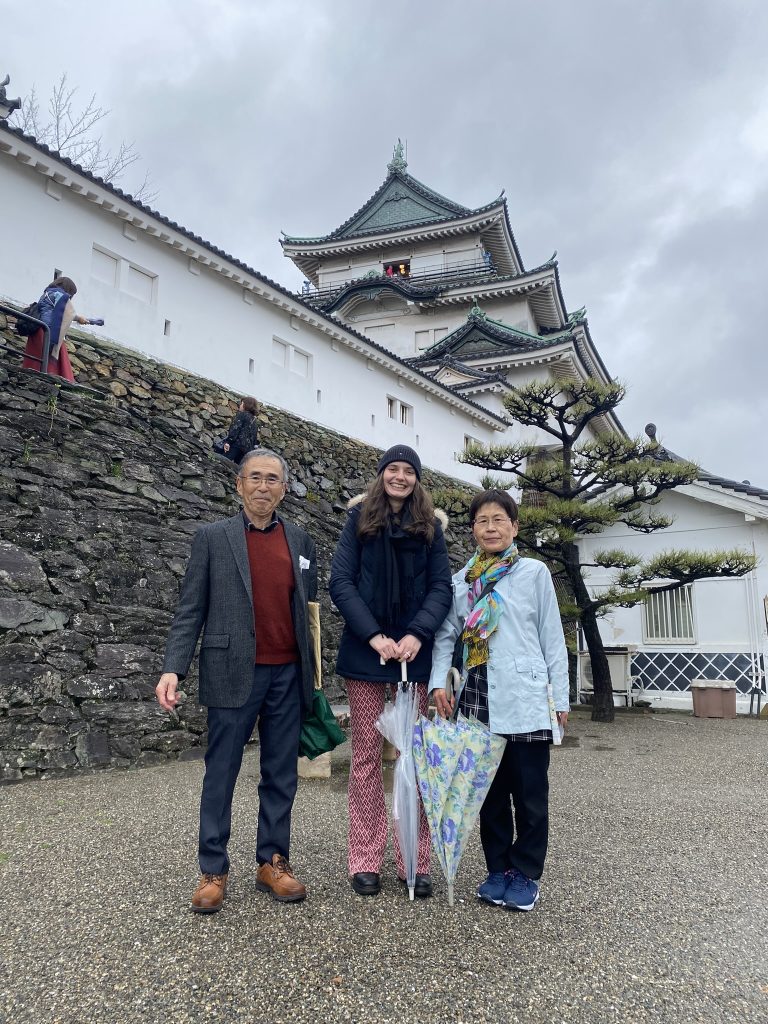
A nice two days with Mrs and Mr Yoshimatsu, in front of Wakayama Castle
However, I am not the first German to arrive there. Carl Köppen (23 August 1833 – 28 June1907) – a German military adviser – was there before me! A member of the Schaumburg-Lippe Jäger Battalion who had quickly made a career for himself, Köppen was invited to teach in Japan as a foreign advisor and train the troops of the Kishū Domain. Köppen, who was stationed at Wakayama Castle between 1869 and 1871, specialised in the use of the Doersch and Baumgarten needle cannon. The latter can be viewed in the castle museum. After exchanging Snapchat with a ninja interested in Germany, we continue on to the Tsunami Educational Centre.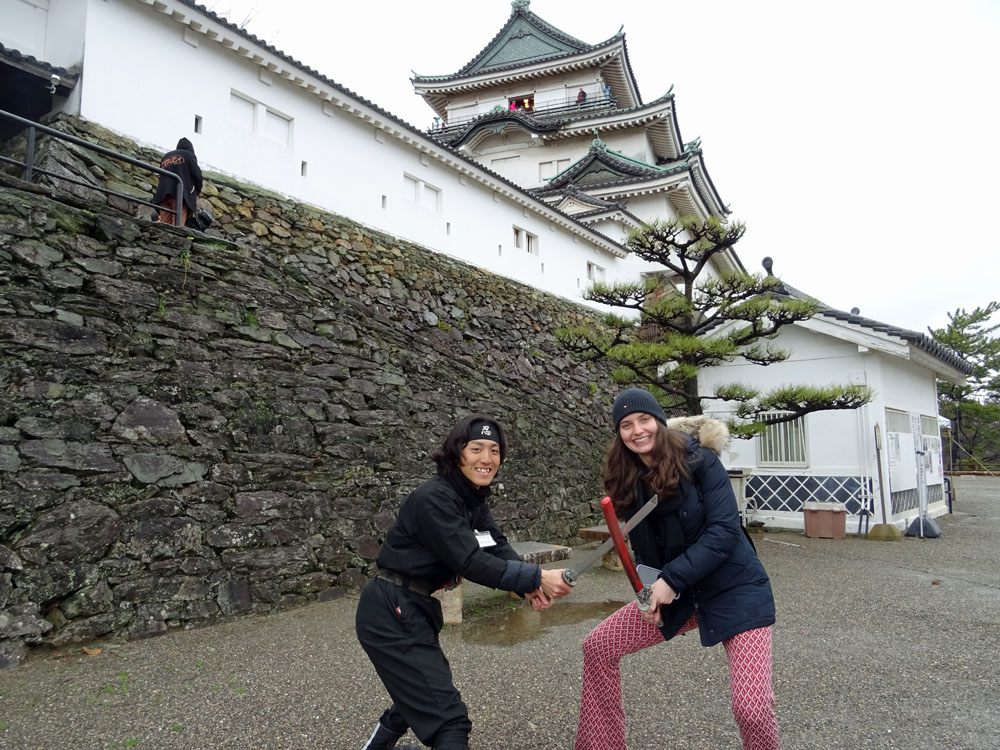
Ninja fights Fee
In the meantime, it has started to rain and classical music from an American radio station is playing in the car. The Tsunami Centre is an education centre and museum where children in particular are taught what to do in the event of an earthquake and subsequent tsunami. After exchanging our street shoes for slippers at the entrance, we find ourselves in a 3D cinema. There, earthquakes and tsunamis are imitated by moving seats, accompanied by an information film. I find the shaking of my chair and my 3D glasses on my nose quite funny at first, but by the end I leave the cinema in tears. At that moment, I really realise for the first time what these natural disasters mean for people’s everyday lives. The film shows a family with two children and how they are trained for emergencies and how parents should train their children: At the weekend, they walk the escape routes together and practise how to get to the highest escape points by running. Information boards show the way to the mountains and the
tsunami rescue centres. The children are trained from an early age to be able to manage these routes on their own in an emergency and not (!) to wait for their parents.
Because in the event of a tsunami, everyone is only responsible for themselves. This increases everyone’s chance of survival, as there is no waiting for others. Comment from the speaker in the film: ,,No matter how small a child is, it must learn to escape on its own, but in the knowledge that its mother will reassure it afterwards. The children also carry contact details with them so that they can be reunited with their parents. The protagonists of the film often say the sentence ”I made a promise”- it is a kind of mantra, reminding everyone that they have made a promise to their families to walk alone towards the higher rescue centres in the event of an emergency. In addition, display cases show what food supplies you should have with you, which items belong in an escape rucksack, how important the community is (active involvement in a women’s and youth club is recommended) and that you should know your neighbours three houses to the right and left. You also learn how older people can be carried
up the mountains by piggybacking them.
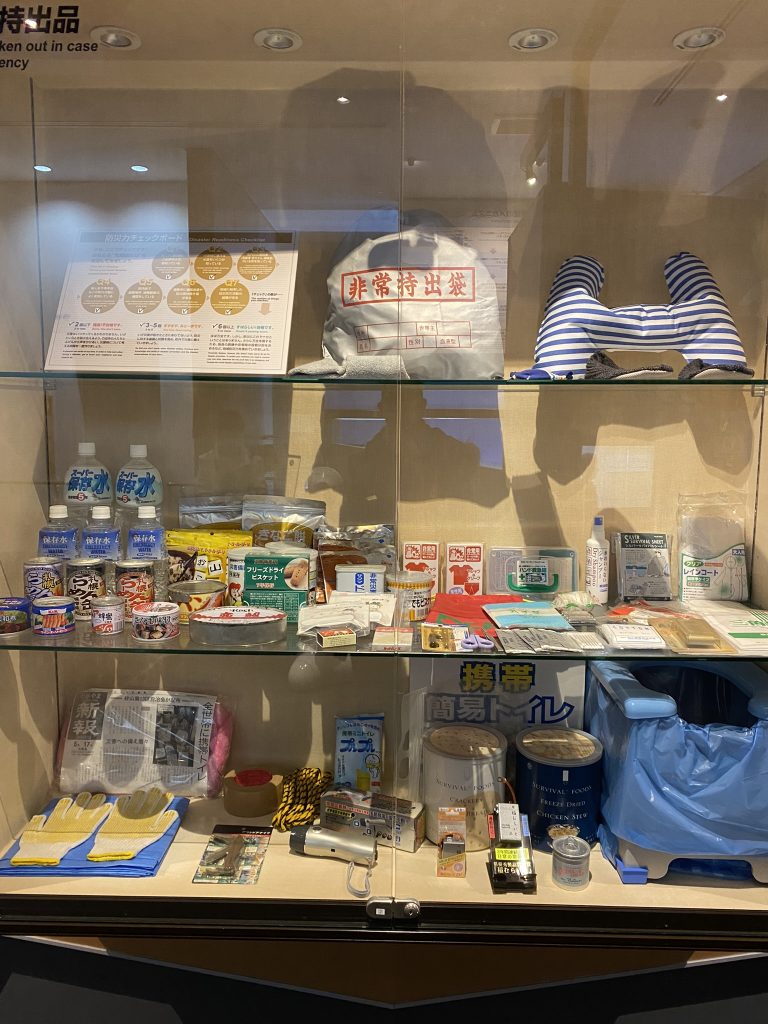

Display cases with important emergency equipment & pictures of children being trained for emergencies
The Tsunami Centre is dedicated to Hamaguchi Goryō. In the hours after the severe Ansei-Nankai earthquake of 1854, he recognised the danger of an impending tsunami and evacuated the residents to a nearby hill where the ”Hiro Hachiman Shrine” is located. The knowledge of the tsunami that follows an earthquake had been passed on to him by his ancestors. As it was night, he ordered the stacked sheaves of rice that were drying after the last harvest to be set on fire. This allowed more than 90 per cent of the villagers to escape the tsunami, as they saw the fire burning in the darkness and knew which way to run. The account of his heroism became required reading in Japanese textbooks. After the disaster, Hamaguchi Goryō worked to rebuild the damaged bridge and spent over four years building a huge embankment wall – the Hiromura Dam. This large-scale project was not only intended to provide disaster protection, but also to create jobs for the villagers who had lost their belongings in the tsunami. The cost of the 600 metre long, 20 metre wide and 5 metre high dam was the equivalent of 4667 ryō and was paid for by Hamaguchi, earning him the nickname ”a living god”. 88 years later, this dam protected the village of Hirogawa from the Tsunami of the Nankai earthquake. To this day, the heroic deeds of Hamaguchi Goryō are celebrated with an annual torch relay in the village.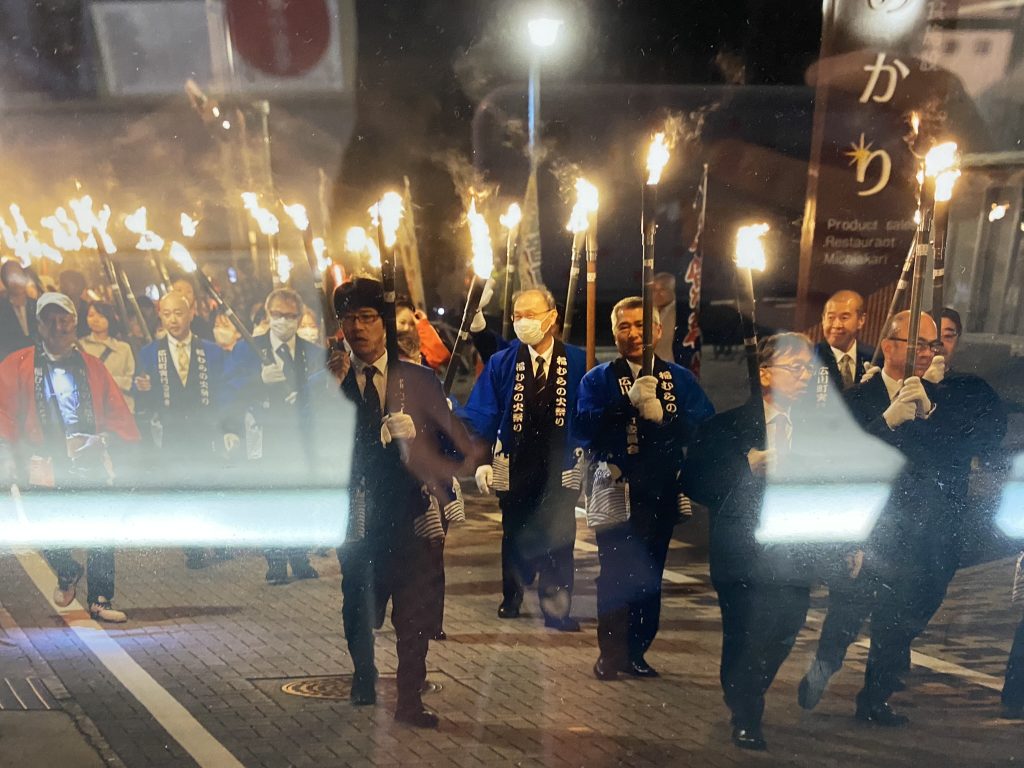
Annual torchlight procession in honour of Hamaguchi Goryō
On the way to Mr and Mrs Yoshimatsu’s house, we drive past the sea. Small fishing boats bob quietly on the water. But the sky is black and it’s starting to rain again. The background soundtrack of dramatic classical music completes my sense of how quickly the weather can change here. Towers with alarm sirens loom out of the landscape at regular intervals. But when I reach the house, I can breathe easy – it is nestled in the mountains, picturesquely nestled between orange trees. The sun is low and bathes the landscape in a marvellous light. I move into my own guesthouse, where a tatami mat is already waiting for me. I am even given an emergency button, so everything has been thought of! After dinner together, I am allowed to put on Mrs Yoshimatsu’s kimono. Or rather, she puts it on me. Like in an origami folding course, I am wrapped layer by layer and ribbon by ribbon like a fortune biscuit. The whole process takes half an hour and I haven’t even got the typical kimono knot on the back yet. Due to time constraints, the decision is made in favour of a bow. The missing minutes could also be related to the upcoming prayer – because after the meal, people gather in front of the house
altar. The prayers, which consist of a mixture of singing, praying and the striking of a loud gong, are dedicated to the ancestors. Their pictures are displayed on a ledge to the right of the altar. Or rather, at least the ones you have of your ancestors. I am also allocated a seat with my kimono and am allowed to attend the prayer. What an honour! Afterwards, I am unwrapped again like a gift and we sit together with biscuits and oranges and talk about Japan and Germany. A big favourite in Japan is apparently the poem about the Heidenröslein. A few verses are recited to me by heart. Someone must have paid more attention at school than I did:
I can only dimly remember hearing the work written by Goethe. To the great astonishment of the Japanese, who are big fans…
If you feel the same way as I do, here it is (again):
A boy saw a little rose,
A little rose on the heath,
Was so young and beautiful in the morning,
He ran quickly to see it near,
Saw it with many joys.
Little roses, little roses, little roses red,
Little rose on the heath.
The boy said: I‘ll break you,
Little rose on the heath!
Little rose said: I‘ll sting you,
That you may think of me forever,
And I will not suffer it.
Little rose, little rose, little rose red,
Little rose on the heath.
And the wild boy broke
’s little horse on the heath;
The little horse resisted and stung,
But no pain and sorrow helped him,
It just had to suffer.
Little rose, little rose, little rose red,
Little rose on the heath.

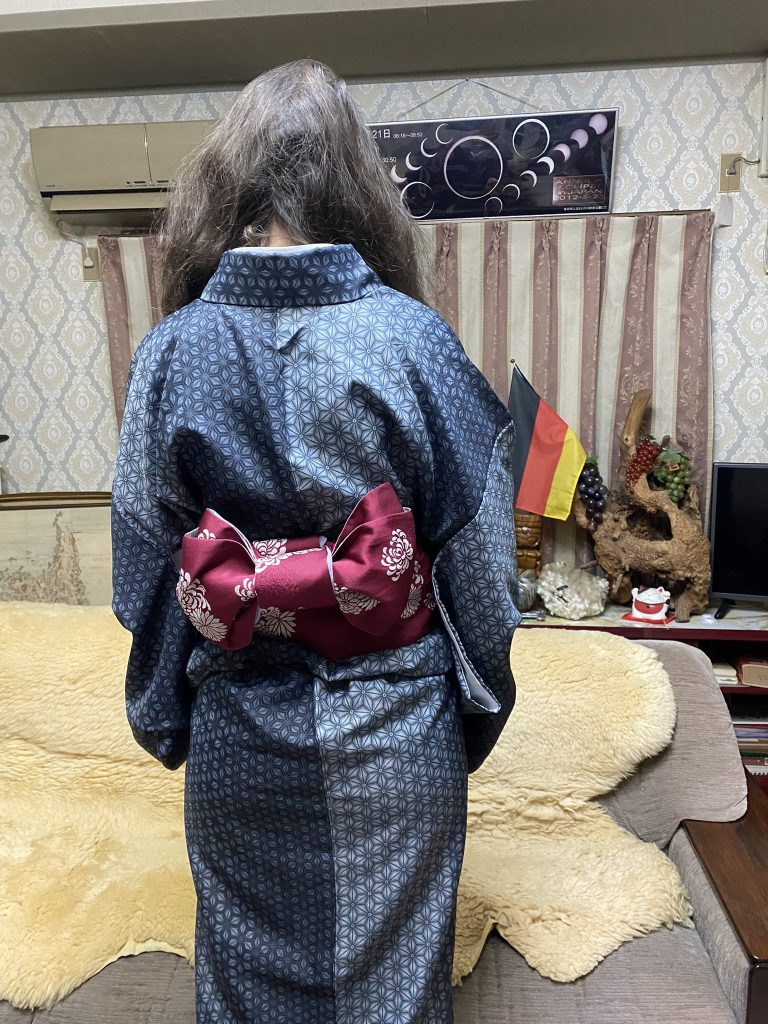
The next day, I have breakfast with Mrs Yoshimatsu. She watches me with interest as I eat my oatmeal, yoghurt and banana, which I was allowed to buy with them in the supermarket the previous afternoon. She also hands me freshly picked oranges from the garden. Unfortunately, as she speaks little to no English and the same applies to my Japanese, we don’t have much to say to each other. As the silence makes me a little uncomfortable, I point to the individual products on the dining table and ask her: ”From Japan?”. She replies in the negative or affirmative to my questions. We also smile encouragingly at each other every few moments -because a smile doesn’t need language!
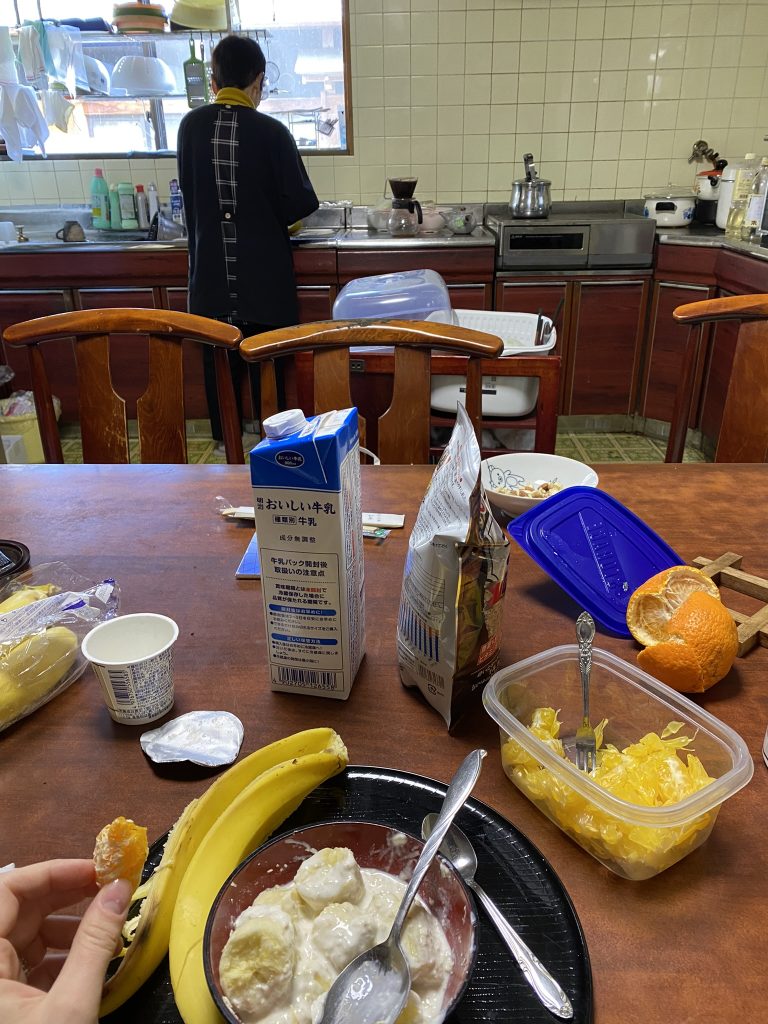
Breakfast with Mrs Yoshimatsu
The wild ride then continues, together with Mozart and Vivaldi, towards the monastery village of Koyasan. After visiting the ”Okunoin”, an old moss-covered cemetery, and the bright red ”Konpon Daito Pagodada”, we have ramen soup. I have a lively and lengthy conversation with Mr Yoshimatsu about their religion, Buddhism, and whether he believes in karma (yes) and life after death (also yes). As do I… I am then dropped off at the station, where my train to Osaka is already waiting. Information boards above the seats show what should be done in the event of a tsunami.
A panda bear shows how to evacuate from a train
Tsunami or not – these have been two exciting and stimulating days that I didn’t see coming! I will always remember Mrs and Mr Yoshimatsu for their generous hospitality! Aligato Toshitakasan!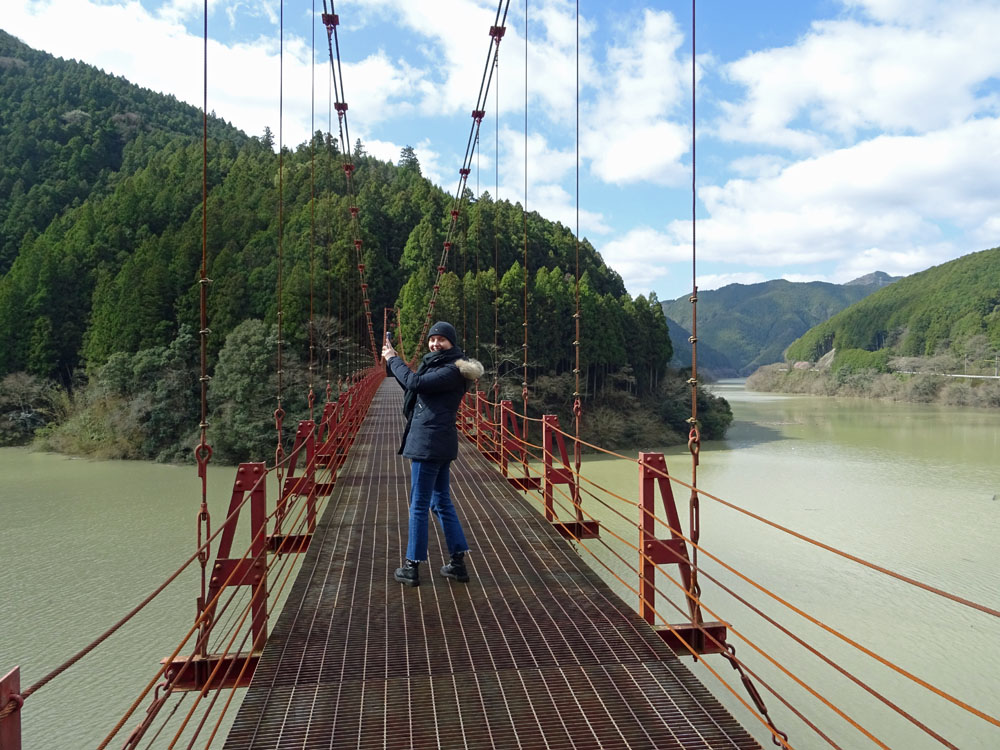
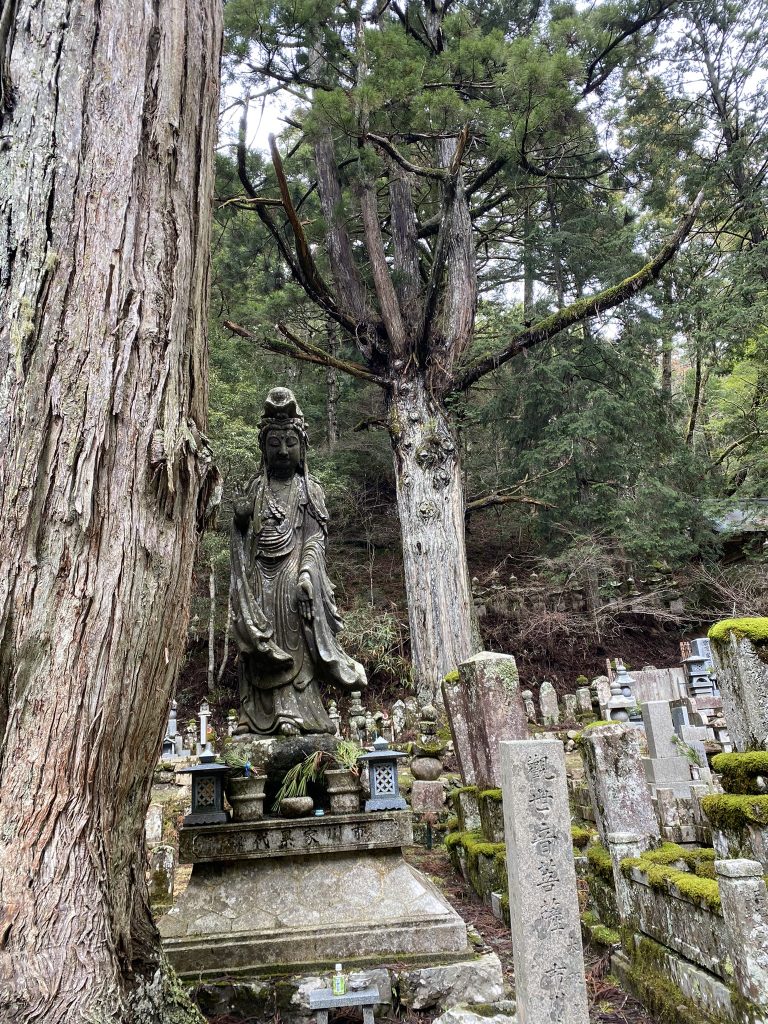
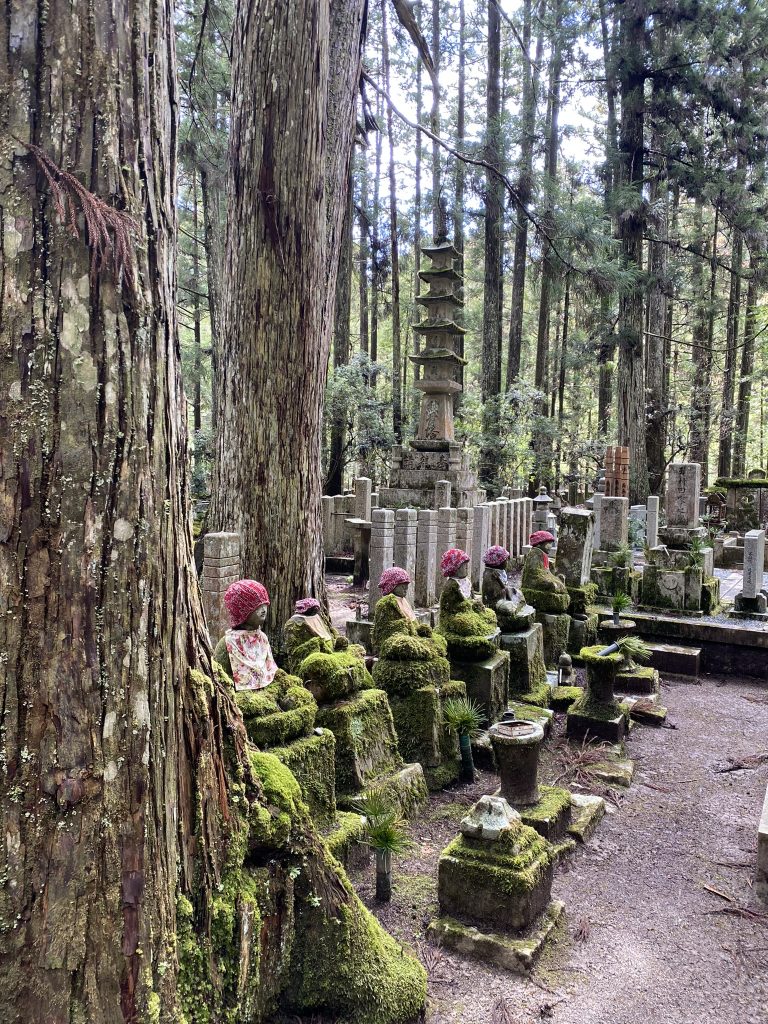

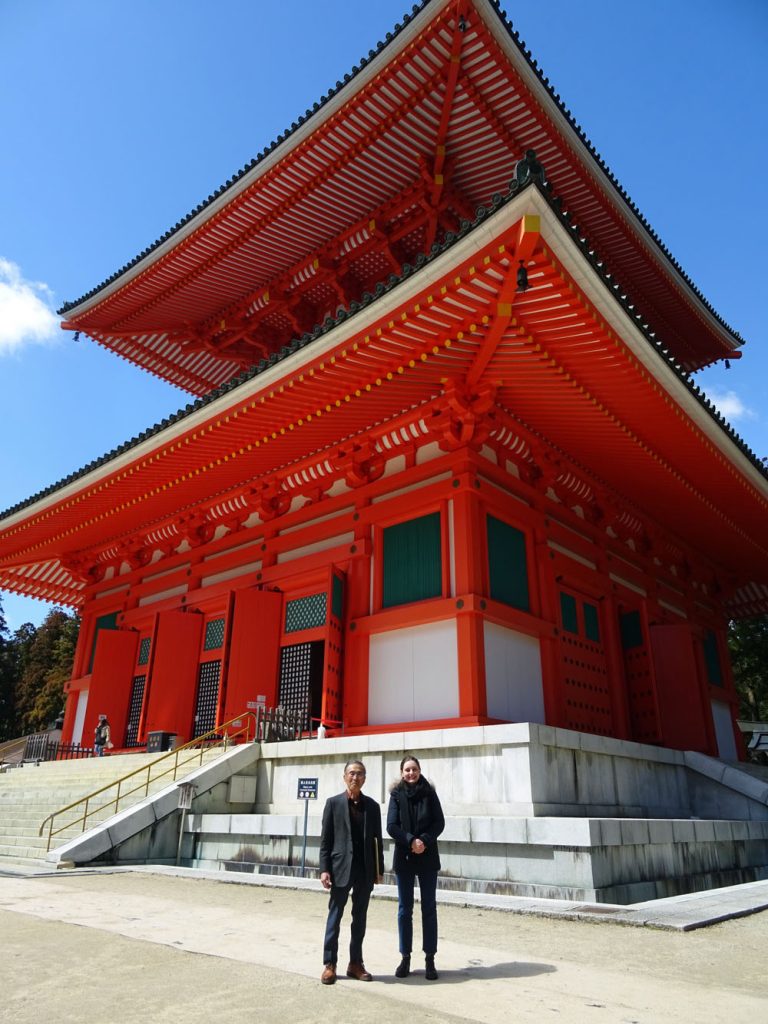
Koyasan and its beautiful temples
Overwhelmed by all the experiences, I take it easy on 28 March and attend a pottery course for Japanese ceramics run by a Spanish woman living in Japan. Her workshop is located in the Teradacho neighbourhood. Almost only older people live there, as it is a less hip part of Osaka. On the way there, I stroll through an old market, where there are lots of ageing houses and original shops. While I’m working on my matcha drinking bowl, master potter Anna emphasises several times that I’m a natural! Nice to hear! At least something for the CV! And the fact that I have discovered a more original corner of Osaka also makes the hours – in addition to a handmade souvenir – a special afternoon.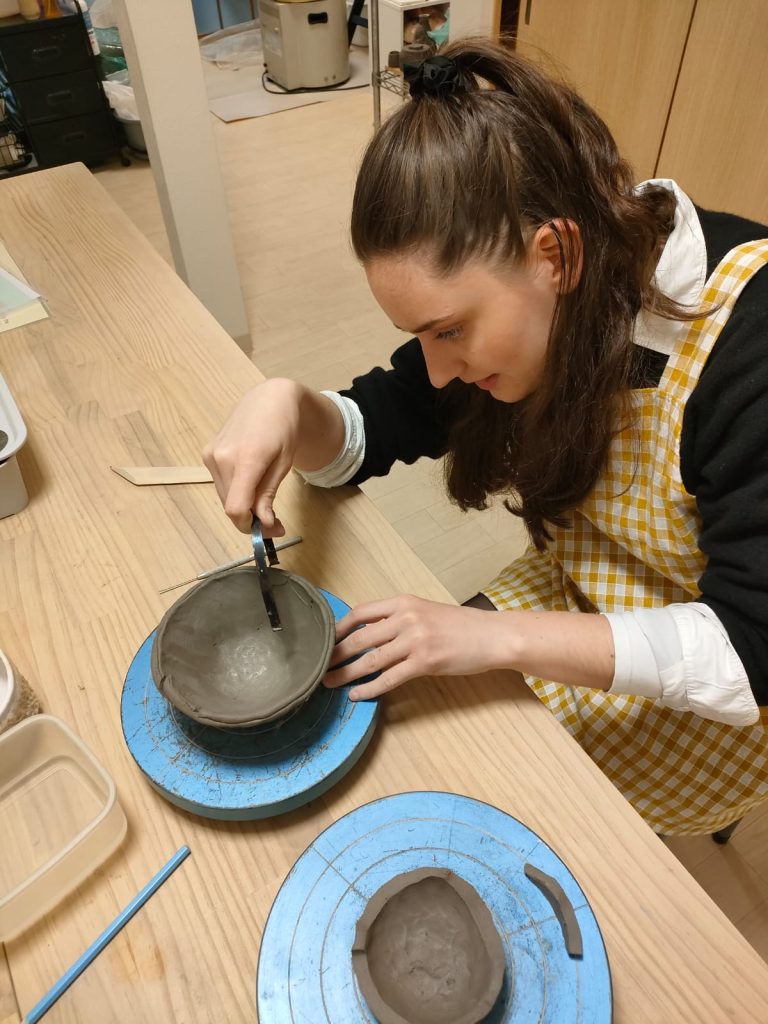
Natural talent pottering a matcha bowl
To round off the week, the aforementioned natural talent (can’t emphasise this enough…) goes on an excursion with the Rotary Club of Osaka. At 9 o’clock in the morning, a coach sets off in the direction of Himeji Castle. On board are 25 Japanese, 15 Taiwanese, 1 German (me in this case) and lots of canned beer – so it promises to be a fun day. Looking out of the window, I briefly thought the bus had taken the wrong exit: Neuschwanstein Castle looms in front of me. But it’s only a replica of the Bavarian original!
Japanese Neuschwanstein Castle
When you arrive at the cable car to the Engyoji Temple, you line up neatly in rows of two – in typical Japanese fashion – before the Doppelmayr lift starts moving. The almost 1000-year-old wooden temple is an imposing structure perched on a mountain between ancient trees. Inside, it smells of incense sticks. I also light some and pray for a safe journey.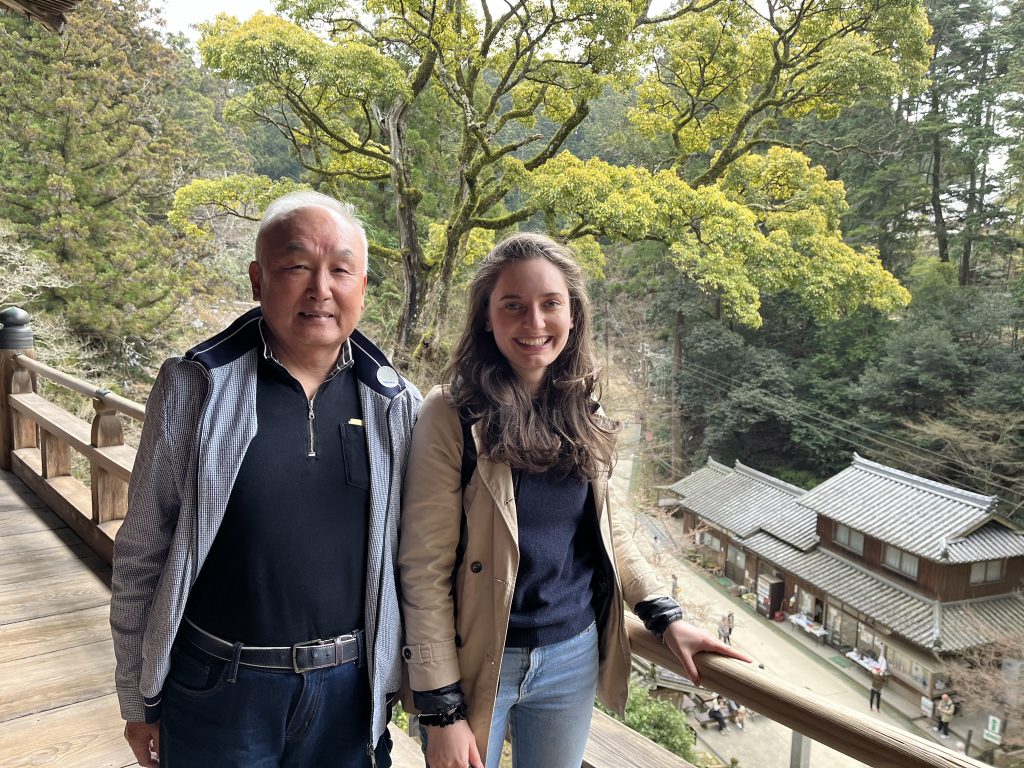
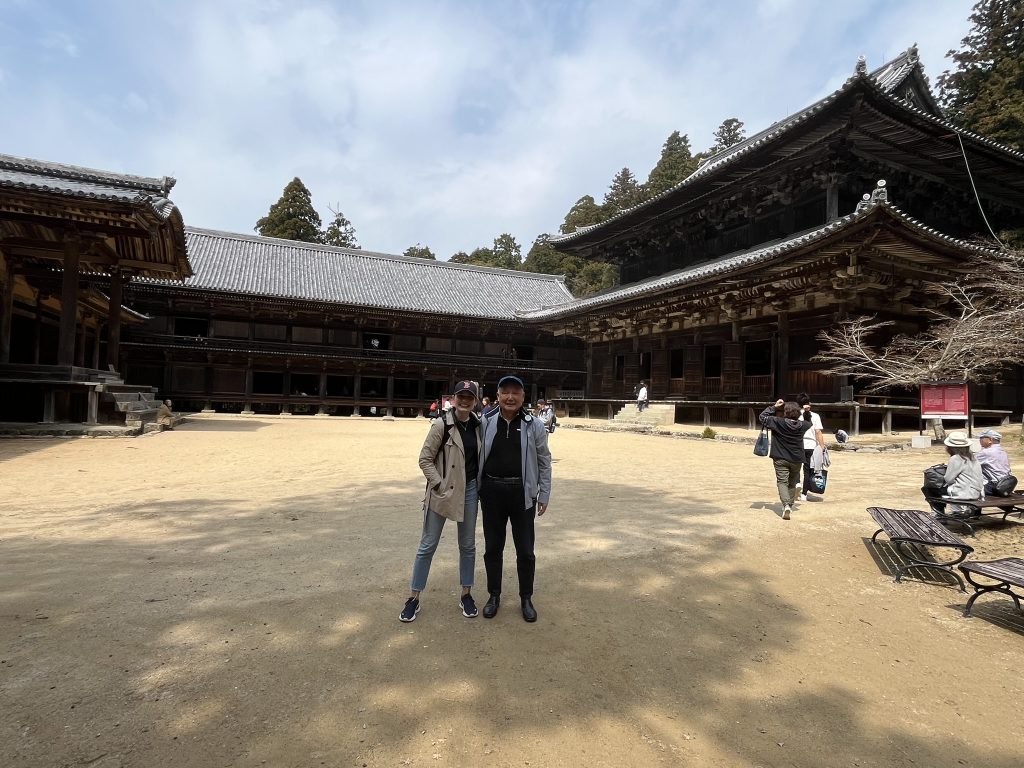
With Oka in front of the Engyoji temple
We continue on to lunch. We are served various Japanese dishes in a hotel, accompanied by beer, wine and sake. But I hold back, as I still want to visit the no, not Neuschwanstein, but Himeji Castle. Once we arrive at the castle gardens, the tour group splits up. Part 1 goes to eat vanilla ice cream in the Japanese castle garden, part 2 walks after the tour guide, recognisable by the flag in her hand, towards the castle. You stand in the castle for about an hour, waiting metre by metre until you finally reach the top floor. It’s hot and the air is bad. In hindsight, I think I would have preferred to join the vanilla ice cream group..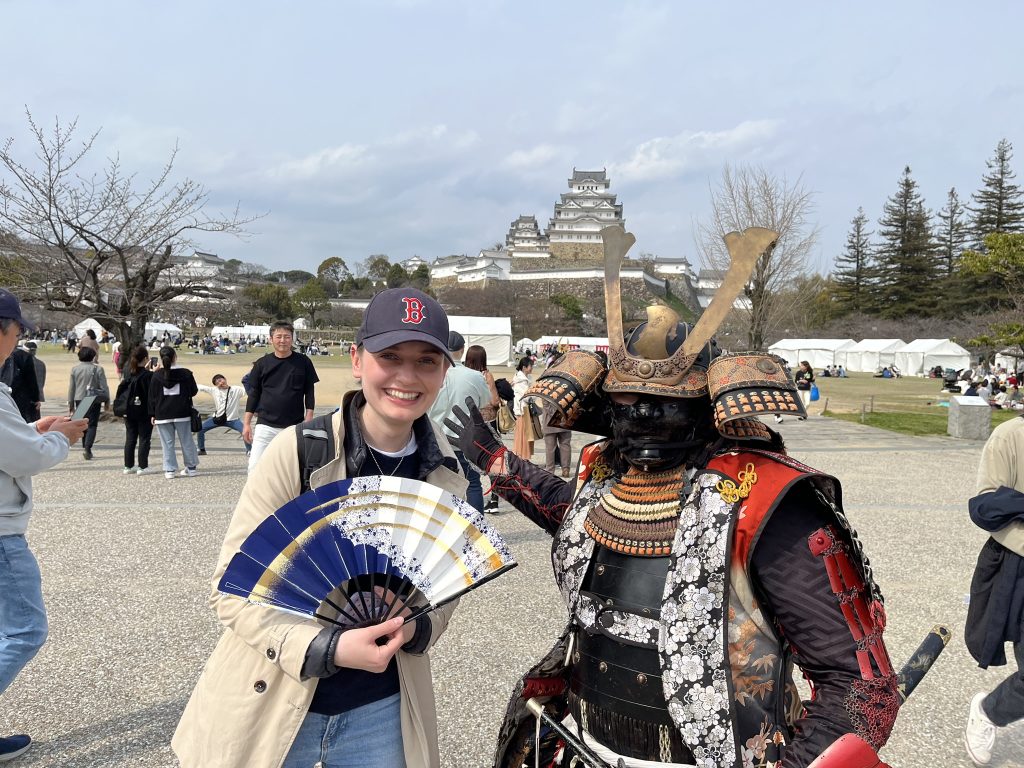
Japanese warrior with Fee in front of Himeji Castle
On the return journey, the whole bus plays bingo together. A small screen displays the
different numbers and music plays to the beat. The game is also moderated. It’s great what Japanese coaches can do. Now for the prize question: What happens when 25 Japanese, 15 Taiwanese and 1 German play bingo against each other? Exactly – the German loses!!! And by a landslide… only five of my 22 bingo numbers on my slip of paper are even called out.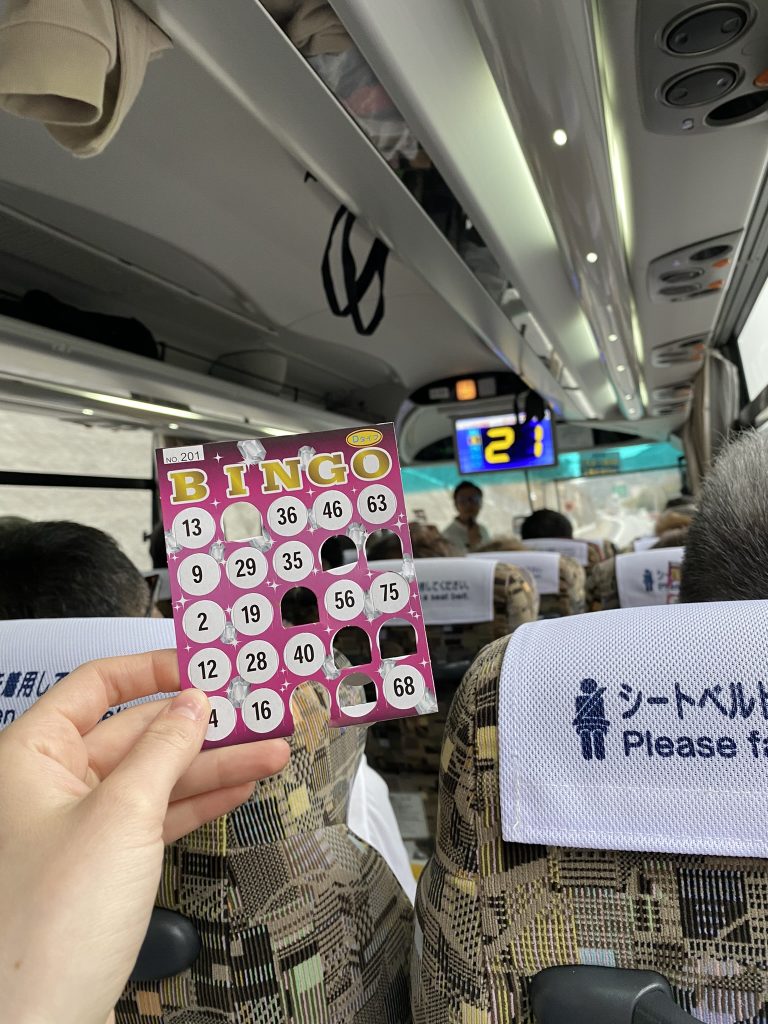
At the subsequent dinner in a Japanese meat temple, different types of meat are brought to the table and grilled on a platter in the table. Beer, sake and wine are served again. What did I learn that day?
1. the Taiwanese are all very nice and very hard-drinking. I saw some really impressive
drinking performances.
2. the Japanese sleep quietly on the bus, sleeping Taiwanese can snore loudly.
3. next time choose vanilla ice cream in the sun rather than looking at the interior of a dark castle.
After this long day, I fall into bed at 11.30pm, dead tired. I won’t forget this trip in a hurry…!

